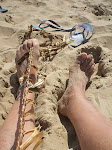The Minho region in northern Portugal,
however is totally different and very similar to Galicia just north of the border in Spain.
Of course this is logical,
the frontier is only a political barrier and
the people both sides of this imaginary line live in similar geography with a
similar ecology. I like Galicia very much (it's a lot like Scotland but warmer) and some of my best experiences there
were times spent accompanying Carlos Fontales on research trips to visit basket makers. These trips were special for me because I had hardly ever before had the opportunity to meet
elderly basket maker/farmers who continue to work with
the materials they gather from the countryside
around them. Carlos has recently published "More Than Baskets", an excellent introduction to popular Spanish basketry in both Spanish and English, which uses some of this research and is available to purchase directly from him.
So, I was hoping that on this occasion I might be able to visit a Portuguese maker and Inez remembered having come across one not far from their home.
So, I was hoping that on this occasion I might be able to visit a Portuguese maker and Inez remembered having come across one not far from their home.
Joaquims' workshop is on the road west out of Cabeceiras de
Basto. He has made baskets for nearly 40 years, originally
with his two brothers, but now on his own. Chestnut
and willow are
his primary materials, both of
which he harvests locally.Willows are
everywhere in the surrounding countryside, not in plantations, but usually pollards at the edges of fields and
alongside the many rivers and streams. Unusually Joaquim makes his own buff willow, boiling and peeling the tannin stained rods. I know of no other
individual maker who uses ‘hedgerow’ willow to do this as the people that I know who use buff willow usually buy it from
commercial growers. Buff willow was very popular for baskets in
Britain, Germany, Poland and other northern European regions (though not France) in the 1960’s but has since gone out of fashion in Britain, perhaps because of its
association with cat and dog baskets. This seems a shame because it is a good
and natural way to help preserve the willow, the
tannin providing some protection against both worm and mould. Unfortunately,
I did not have the opportunity to see what set up Joaquim uses for his buffing but
he described it as a tin bath with a fire under it! His ‘shop’ has a window on the road where he puts a couple
of baskets to act as a sign. Next to the shop is a spring with a water
tank and a pond. I didn’t establish if this was where he soaked his materials
but it would be surprising if he didn’t.
Sadly he has passed his knowledge to no-one else
so it will die with him. He would have taught someone but, he
said, the young people were not interested because they cannot make enough money from basket making. This is
hardly surprising as Joaquim was only charging 20€ for a large log basket out of
split chestnut. At the very least it would have taken five hours to make taking into account the
finding, harvesting, cooking, splitting and shaving of the chestnut prior to
any weaving! But what counts as 'enough money to live on' is, of course, relative. I do not imagine that Joaquim spends his spare time in the local shopping centre coveting i-phones and he probably grows a lot of his food and lives in a house he inherited from his parents, so 'enough' for him is 20€.
It was a slightly chaotic workshop, the floor strewn with materials and finished baskets. It made it difficult to look at the work but those that I could see included covered wine jars, market baskets, some with dyed willow included, log baskets and fans for the fire. He gave the impression of being someone who enjoys making baskets much more than selling them! I'm with him on that one.
Similar baskets were on sale at the weekly market in Cabeceiras, as well as some that looked like Chinese imports. The latter having thinly split wood, handles wrapped in string, plywood bases and fabric linings. A lining always suggests Chinese origins, they use them a lot in their commercial basketry manufacture so that they don’t have to spend time trimming the ends on the inside of the basket. If you look under the lining of one you will see what I mean! These did not seem like Portuguese baskets to me, but since then Inez has sent me some pictures of other baskets seen at a market, where the maker was actually working, that also have plywood bases and linings, so perhaps this is a Portuguese practise too? Maybe someone out there knows the truth? Some of the baskets with structures out of split chestnut were woven with what looked like bamboo rather than Mediterranean cane, which also surprised me, as hazel was more evident in the landscape than either cane or bamboo and again this suggested that the basket came from somewhere else. My Portuguese is less than minimal so interrogating the stall holder was not possible.
I did buy a chestnut and strapping tape fan that had definitely
been locally made and wasn’t actually for sale.
The stall holder was using it to fan roasting
chestnuts but he came up with a price quick enough when asked. I wasn’t going to quibble even
though I know that buying a hand woven fan in Europe for
two euros is never going to provide a young maker with 'enough' to live on .













